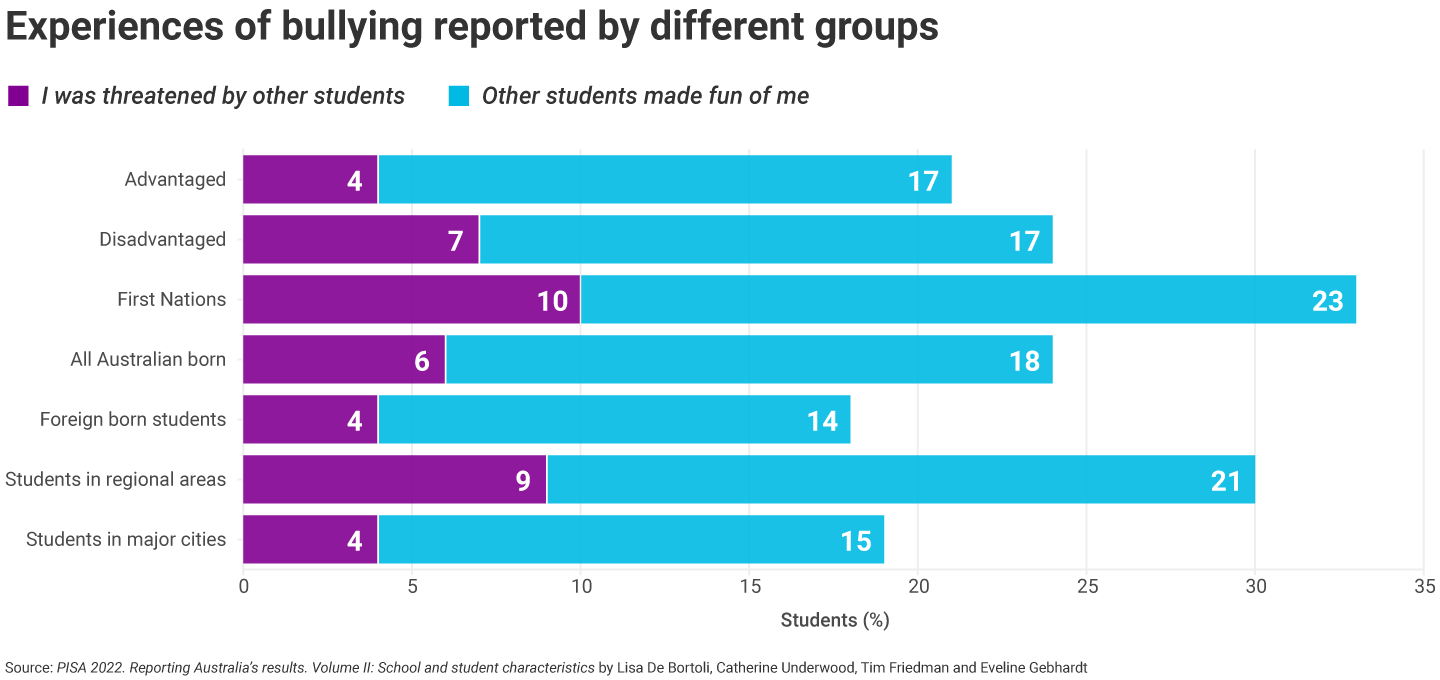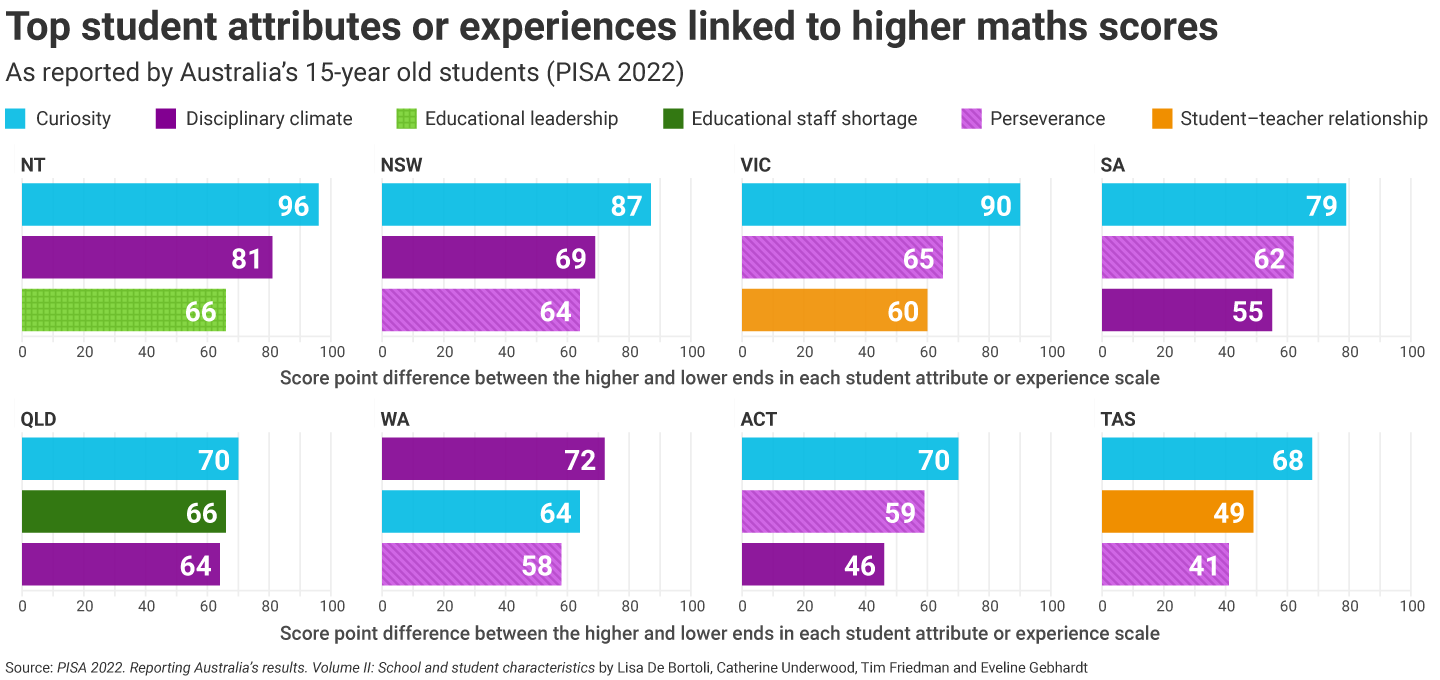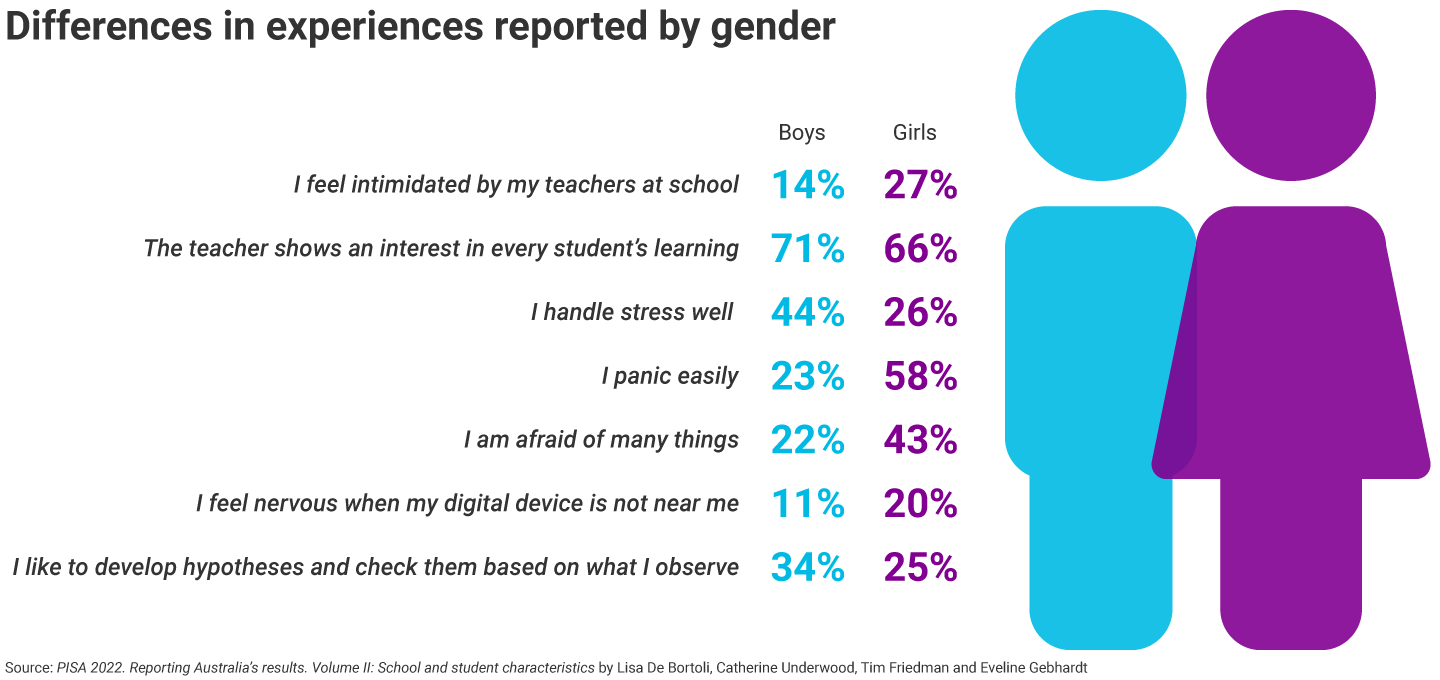
PISA reveals student experiences that help – and derail – maths performance
Research 21 May 2024 8 minute readTeenagers in every Australian state and territory experienced disruptive maths classrooms and bullying at greater levels than the OECD average, a new report on student experiences shows.
The Australian Council for Educational Research (ACER) has released the report – a second volume exploring Australian data from the 2022 Programme for International Student Assessment (PISA).
PISA examines how 15-year-old students are able to apply their knowledge in maths, reading and science for real-world problem solving.
In Volume 2, researchers have analysed questionnaire responses from principals and more than 13,430 Australian students, to portray their school experiences and how these impact on maths performance.
They compared 24 of the 81 participating countries and economies, selecting those that performed higher or at the same level as Australia in maths, as well as every Australian state and territory.
Their findings highlight concerns for Australian education – such as persistently poor outcomes for disadvantaged students and higher stress levels experienced by girls.
But they also identify behaviours and environmental conditions that contributed to a good maths performance and can be used by schools and policymakers to plan for better outcomes.
The areas associated with higher performance included high levels of curiosity, strong relationships with teachers, a strong sense of belonging and safety at school, low exposure (or no exposure) to bullying, resistance to stress, a favourable disciplinary climate in class, and perseverance.
Students from advantaged backgrounds and those in metropolitan areas fared better in most of these areas than those from disadvantaged backgrounds.
ACER’s first PISA 2022 report showed that disadvantaged students were 6 times more likely to be low performers in maths than advantaged students and that the achievement gap between these two groups had grown by 19 points (or about 1 year of learning) since 2018.
Volume 2 provides greater insight into the challenges faced by disadvantaged students, with a greater proportion (than advantaged students) reporting learning in a ‘less favourable disciplinary climate’, lower levels of teacher support, and feeling less safe at school.
Researchers refer to a bullying index developed using identified behaviours including being purposefully left out, threatened by other students and wilful damage of property.
Using the index, they found that all Australian states and territories had higher levels of bullying than the OECD average. Australian-born students, those from disadvantaged backgrounds and those in regional areas reported the greatest exposure to bullying.
Double the percentage of First Nations students (10 %, compared to 5% for non-First Nations students) reported being threatened by other students.

How impact varies between jurisdictions
Volume 2 reveals the complex nature of experiences that contribute to a school’s ability to provide a good education, and 15-year-old students to learn well.
It shows the impact of similar experiences on student maths performance differed greatly between jurisdictions.
For example, nationally, students whose principals reported higher levels of parents discussing their child’s progress at a teacher’s instigation performed 6 score points higher than those students whose parents didn’t. However, in South Australia, the score point difference was 27 points (or more than 1 year of learning), while in the Northern Territory it was 72 points (or more than 3 years of learning), researchers found.
Drawing on student responses about behaviours including remaining calm under stress, being nervous about exams, and ‘afraid of many things’, a ‘resistance to stress’ index was created from PISA 2022 results.
Students in the Northern Territory reported greater resistance to stress than any other jurisdiction, and higher than the OECD average. In this area also, researchers found a significant impact on Northern Territory student maths performance.
‘Generally, students in the highest quarter of the stress resistance index scored 24 points higher those in the lowest quarter in maths,’ the report found. The difference for Northern Territory students was more than double this figure, at 52 points.
In 5 jurisdictions – Queensland, Western Australia, South Australia, New South Wales and Victoria – students in the highest quarter of the bullying index (with greatest exposure to bullying) scored lower in maths than those in the lowest quarter.
However, the report showed a greater impact in Queensland, where the score point difference was 40 points, compared to 20 points in South Australia.
Using a perseverance index, the report showed a link between students in the highest quarter (showing greatest perseverance) and higher maths performance, with a score point difference ranging from 41 points in Tasmania, to 65 points in Victoria.

Curiosity a strong marker for performance
Curiosity was measured for the first time in PISA 2022, with the index including student behaviours such as asking questions, developing hypotheses, knowing how things work, learning new things and boredom.
Students in Singapore, the highest performing country in PISA 2022, showed the greatest curiosity, followed by Korea and Canada. These were the only countries to have a significantly higher index score than Australia, with the Netherlands showing the lowest index score overall.
ACER researchers note that ‘curiosity is associated with greater psychological wellbeing’ and ‘leads to more enjoyment and participation in school and higher academic achievement.’
They found that Australia’s foreign-born students reported being more curious than Australian-born students, with 74% compared to 66% reporting that they liked learning new things.
Compared to other indexes, curiosity showed the highest score point differences in maths performance between those in the top quarter (showing the greatest levels of curiosity) and those in the lowest quarter – at 81 points.
The difference ranged from 64 points in Western Australia to 96 points in the Northern Territory, with students in the Australian Capital Territory and New South Wales showing the highest levels of curiosity overall.
Girls experienced education differently
ACER’s Volume 1 report showed that, across OECD countries, the mean score for maths performance was 9 points lower for girls than it was for boys. In Australia, the difference was 12 points.
Volume 2 shows that girls experienced school very differently to boys in 2022, with a greater number reporting that they panicked easily (58% compared to 23%), got nervous easily (71% v 39%) and felt nervous about approaching exams (75% v 49%).

Almost double the percentage of girls reported feeling anxious when they didn’t have their digital device near them (20% v 11%). Overall, students who reported feeling this way scored 37 points lower than those who reported never feeling this way or feeling it ‘half the time’. Despite a greater percentage of girls than boys reporting that their teachers were respectful toward them (90% v 88%), they also reported less belief in teachers being interested in every student’s learning in maths classes (66% v 71%).
Overall, on average, 70% of Australian students reported that in most or every maths class, the teacher took an interest in every student’s learning, continued helping until students understood and gave extra help where it was needed.
This was higher than in most of the comparison countries that performed higher or at the same level as Australia in maths.
Further information
Read the reports:
PISA 2022. Reporting Australia’s results. Volume II: School and student characteristics by Lisa De Bortoli, Catherine Underwood, Tim Friedman and Eveline Gebhardt
PISA 2022. Reporting Australia’s results. Volume I: Student performance and equity in education by Lisa De Bortoli, Catherine Underwood and Sue Thomson
PISA in Brief 2022: Student performance and equity in education by Lisa De Bortoli, Catherine Underwood and Sue Thomson